Tuesday, 17th August 2021
The Tribunals Reforms Bill, 2021
In News
The Supreme Court has asked the government to show material justifying reasons for introducing Tribunal Reforms Bill, 2021.
About the News
- The Supreme Court asked the government to produce material showing its reasons for introducing the Tribunal Reforms Bill of 2021, which abolishes nine appellate tribunals and revives provisions of an ordinance struck down by the Supreme Court, in the Parliament.
- Also, some of the provisions in the ordinance regarding conditions of service and tenure of Tribunal Members and Chairpersons, which were struck down by the Supreme Court, have been reintroduced.
- No Discussion: The Bill was passed in the Lok Sabha by voice vote without a debate.
- High Vacancies: The Supreme Court has also expressed its discontentment over the functioning of tribunals in the country, given that they are understaffed.
- Despite the Supreme Court’s observations showing over 240 vacancies in key tribunals where thousands of cases were pending, not a single appointment had been made by the government in any of these tribunals till date.
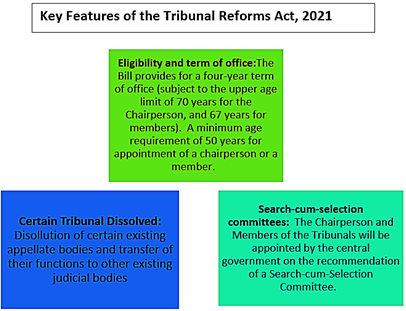
The Contentious Issues
- Age criteria and Tenure: Among the thorny provisions in the law is the minimum age criterion of 50 years for appointment of advocates as members of tribunals and the four-year tenure that the amendment prescribes.
- As per the Supreme Court, fixing a minimum age for recruitment of members as 50 years would act as a deterrent for competent advocates to seek appointment. But the government has argued that the move will bring in a specialised talent pool of advocates to pick from.
- Search-cum-selection committee: Apart from the CJI, this committee will also comprise two government secretaries nominated by the government, the outgoing chairperson of the tribunal (in case of appointment of the chairperson), the sitting chairperson of the tribunal (in case of appointment of a tribunal member), and a retired Supreme Court judge or a retired high court chief justice to be nominated by the CJI (in case of a tribunal chairperson seeking reappointment).
- The bone of contention here, though, is Section 3(7) of the bill, which says that the search-cum-selection committee shall recommend a panel of two names for appointment to the posts of chairperson and members, and the central government shall take a decision on the committee’s recommendation within three months.
Sources:
- Explained: Supreme Court remarks on tribunal law is latest flashpoint between legislature, judiciary
- Parliament passes tribunal reforms bill, but here’s why it could cause Supreme Court heartburn
- SC asks govt. to show material justifying reasons for introducing Tribunal Reforms Bill
- The Tribunals Reforms Bill, 2021
Government circulates ‘Draft electricity rules 2021’ to provide green energy open access.
In News
Government has released ‘Draft Electricity Rules 2021’ in order to further advance its objective of achieving clean energy targets.

Key Features of the Rules
- The rules focus on purchase and consumption of green energy including the energy from Waste-to-Energy plants.
- Green Energy: As per the draft rules Green Energy is the one generated from natural resources, such as sunlight, wind or water which are usually renewable sources of energy.
- Renewable Purchase Obligation: The rules provide for uniform Renewable Purchase Obligation, on all obligated entities like the distribution licensees, open access consumers and captive power consumers.
- Procurement: In order to purchase the energy following ways are defined
- A consumer can set up their own power generation plant from renewable energy sources.
- Purchase it from any developer through open access.
- Renewable energy certificates can also be purchased by those who have to meet Renewable Purchase Obligation.
- Renewable Purchase Obligation can also be met by purchasing Green Hydrogen.
- Green Hydrogen: It is the hydrogen produced from renewable sources using electricity.
- Green energy Open Access: An appropriate commission will be set up which will provide for rules for the consumers who would want to consume green energy, but the minimum demand for energy should be hundred kW and above.
- All applications for open access of Green Energy shall be granted within a maximum of 15 days.
- Nodal Agency: A Nodal Agency will be set up which will be responsible for processing all the applications under green energy open access and will act as a system of single window clearance.
- Green Energy Tariff: The tariff for the green energy will be provided by an Appropriate Commission, which may comprise of the average pooled power purchase cost of the renewable energy, cross-subsidy charges (if any) and service charges covering all prudent cost of the distribution licensee for providing the green energy.
Sources
- Government circulates ‘Draft electricity rules 2021’ to provide green energy open
- Green Energy in India: Centre Releases Draft Rules 2021; Top Points
- Draft electricity rules
Image Source:
Standardizing Bidding Process for Government Projects
In News: The government e-market (GeM) will be expanding its operations into government projects this year with a market worth of ₹10 trillion by developing end-to-end contactless and paperless systems, to bring standardization and transparency in government bidding process, starting with the panchayat and urban local body levels.
Understanding Government e-Market (GeM)
- Government e-Marketplace (GeM) is a one stop portal to facilitate online procurement of common use Goods & Services required by various Government Departments / Organizations / PSUs.
- GeM aims to enhance transparency, efficiency, and speed in public procurement.
- It provides the tools of e-bidding, reverse e-auction, and demand aggregation to facilitate the government users achieve the best value for their money.
- The purchases through GeM by Government users have been authorized and made mandatory by Ministry of Finance by adding a new Rule No. 149 in the General Financial Rules, 2017.
How is it different from the earlier system?
- GeM helps central and state government departments achieve the best value for the money of taxpayers by carrying out efficient public procurement using tools such as e-bidding.
- The earlier system involved physical invitation of bids, bid evaluation, and finalization of the winning bid under the directorate general of supplies and disposals, a century-old government procurement arm.
- GeM will now diversify into the projects bidding process of governments and central public sector enterprises (CPSEs), after initially focusing on government procurement of goods and services.
- It aims to come up with an RFP (Request For Proposal) builder to standardize the non-standardized bidding process and procedure that will provide end-to-end service from payment and project implementation to the post contracting stage.
- It will facilitate milestone-based payments and e-measurement of progress of the project on a dashboard for real-time monitoring.
Source:
Youth Development
In News
India has been ranked 122nd out of 181 countries on Global Youth Development Index, released by the Commonwealth Secretariat in London.
About the News
- The triennial rankings of youth development found India among the top five risers on the index between 2010 and 2018, alongside Afghanistan and Russia, advancing their score on average by 15.74 per cent across areas such as education and employment.
- The Youth Development Index is a vital tool which has already significantly enhanced our capacity to assess the extent to which youth are engaged to contribute beneficially in their societies, and empowered by enabling policies and tools.
Who is Youth and what is Youth Development?
- Youth is often indicated as a person between the age where he/she leaves compulsory education, and the age at which he/she finds his/her first employment. In India’s National Youth Policy-2014, the youth age-group is defined as 15-29 years.
- The youth population (15-29 years) globally stands at 1.8 billion. Out of which, every fifth person (20 percent) resides in India.
- Youth development is a process that prepares a young person to meet the challenges of adolescence and adulthood and achieve his or her full potential.
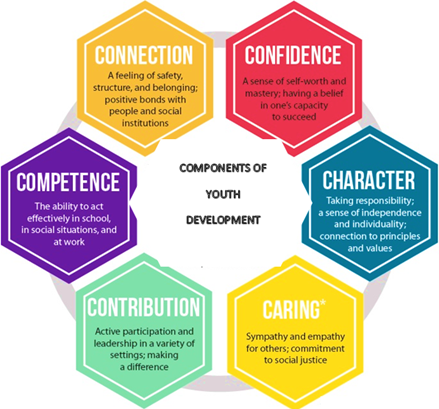
Why is Youth development important for a country?
- Legacy and Future: Youth reproduce– meaning, they can take up the position left by their elders and put in efforts to further grow and develop. They protect their culture and tradition while at the same time, acknowledge and embrace changes. Youth’s actions and inaction both contribute to the state of the Nation.
- Actors of Change: Youth is that passé in which significant and revolutionary thoughts spring to mind and contour the world we live in. They are catalyst in many changes like:
- Societal: The pivotal role of youth who are afresh with ideas and not ideals, will help in movement towards a transparent civil society structure which can influence the political administration to benefit the society.
- Political: Youth can contribute immensely to the politics of the country. If a nation does not rejuvenate its political leadership profile it would become old in thought and slow in action.
- Poverty eradication: One of the keys to empowering the youth is with skill development. When a youth is equipped with essential skills, he/she can utilize them to feed, assist others, and even invest for future use, aiding the nation economically.
- Achieving the SDG: To a great extent, the world’s ability to attain the SDGs by 2030 will depend on the capabilities of the young and the opportunities available to them.
- Economic Drivers: At present, about 34% of India's Gross National Income (GNI) is contributed by the youth. A World Bank report has pegged the projected cost of not investing in youth at 4% of the GDP/year. Of this, the costs of unemployment account for 0.6%.
- Since young people are the most productive workforce of a nation, India is expected to become the 4th largest economy by 2025, contributing about 6 percent to the world GDP. We need to empower youth and enable them to find their rightful place.
- Crime reduction and Security: It is easy for a young impressionable mind to get waylaid and get entrapped in anti-social activities because they were not empowered morally, academically as well as financially. Empowerment enables a young mind to differentiate the wrong from the right, denouncing the path of injustice for a respectable living.
- Security: The youth are the pulse and strength of the nation and with their alertness and if channelized correctly, they can ensure and enhance the security of the country.
Hurdles to Youth development
- Education: Low quality education, early school drop-out (especially in girls), engagement in home business and work or lack of access to schools are the major hurdles of education of youth. Studies show a strong connection—particularly for girls— between basic education and improved earning potential, the growth of democracy, and protection of the environment.
- Economic Opportunities: Factors like high unemployment, low wages, the competition for new jobs, and the contractual nature of jobs are major hurdles to realise the full potential of the youth. About 30% of youth fall under the ‘neither in employment nor in education’ category and 33% of India’s skilled youth are unemployed.
- Health and well-being: Young people who aspire to become politicians, entrepreneurs, civil servants etc. have to bear a disproportionate risks due to large competition, leading to mental health issues or life risks. India also stands as the third-largest HIV epidemic in the world—along with tuberculosis, malaria, and other neglected tropical diseases
- India has the lowest healthcare spending in the world despite having the highest youth population which can be help in accelerating the development our economy.
- Female Youth: Despite years of developmental efforts, young women continue to face a particularly challenging set of educational, employment, and health barriers. Lack of access to toilets, menstrual hygiene, early marriage, and pregnancy leads to poor quality of life and health.
Way Forward
- Right time to Act: India has just a decade’s time to seize the opportunity and realise this youth demographic dividend. Therefore, it is an appropriate time to launch an Indian Youth Guarantee (IYG) programme, akin to the European Union Youth Guarantee (EU-YG). An IYG initiative, with statutory backing, can function as a facilitatory framework for ensuring gainful and productive engagement of youth.
- Budgetary Resource Allocation: At a time of fiscal stress, one way to allocate budgetary resources would be to create a Youth Component Plan, earmarking a specific percentage of funds under a separate head on the lines of the Special Component Plan for the Scheduled Castes and the Tribal Sub-Plan.
- Youth Empowerment: Capacity building as well as skill development of the youth population will mark an initiation of the much-required empowerment. A politically empowered youth will not only acquire knowledge and skills for their personal growth but also promote national integrity by developing leadership and bringing about drastic changes in policymaking while catering to their rights and duties for the nation.
- To ensure social empowerment of youth to overcome challenges like early marriage, women empowerment, their education, and financial stability.

Question: What is the significance of youth for development of a nation. Analyse the hurdles to youth development for a country like India.
Sources:
- Global Youth Development Index (YDI)
- India ranks 122nd on new Global Youth Development Index
- Empower the youth first
- NATIONAL PROGRAMME FOR YOUTH AND ADOLESCENT DEVELOPMENT
- Youth Development In India
- Youth development and health agenda 2030
- Importance of Youth Empowerment
- Principles for Youth Development
- CONTRIBUTION OF YOUTH IN NATION BUILDING
- The 5C’s of Positive Youth DevelopmentCatalyzing Youth Potential: IREX’s Approach to Youth Development
This Day in History - Radcliffe Line
On August 17, 1947, the Radcliffe Line, the geopolitical border that divides India and Pakistan, came into existence. It was formed following the partition. The architect of the Radcliffe Line was Sir Cyril Radcliffe. The western side of the line is known as Indo-Pakistani border and its eastern side as Indo-Bangladesh border. The boundary had been finalised on 12 August 1947 but was published two days after Partition i.e. 17 August 1947.
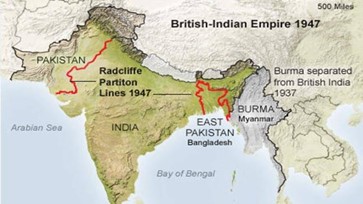
Sources:
Image of the Day - Crisis in Afghanistan
This is the image of young Afghan nationals running beside the US Air Force plane in Kabul. Thousands of Afghan nationals thronged to the Hamid Karzai International Airport in Kabul to leave Afghanistan as the Taliban takes hold of the country. The young nationals mostly comprised people who had helped the American government in Afghanistan.

Source:
SAMVAD Initiative
- Context: launch of 2nd phase of the SAMVAD programme.
- SAMVAD stands for Support, Advocacy & Mental health interventions for children in Vulnerable circumstances And Distress.
- It is a national initiative and integrated resource that works in child protection, mental health, and psychosocial care.
- SAMVAD is funded by the Ministry of Women and Child Development, led by the National Institute of Mental Health and Neuro Sciences (NIMHANS) and is run in collaboration with Panchayati Raj Ministry.
- It encompasses a specialized training curriculum on childhood trauma, interventions for children in conflict with the law, forensics in child and adolescent psychiatry and mental health, education support to children with special needs, protection, and care in the context of adoption etc.
- The initiative is providing training close to 1 lakh stakeholders comprising Child Protection Functionaries, tele-counsellors, educators, law professionals among others.
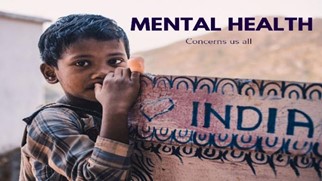
Source:
- Union WCD Minister Smt. Smriti Irani launches 2nd Phase of SAMVAD to Ensure Holistic Psychosocial Well-Being of Children & Adolescents
- Govt., NIMHANS tie up for mental health outreach to children
Image Source:
Greater Adjutant Storks
- Context: Biharhas decided to tag greater adjutant storks with GPS trackers to monitor their movement as part of efforts to conserve them.
- Greater Adjutant Storks (Leptoptilos dubius), locally known as ‘Garuda’, is a member of the stork family, Ciconiidae.
- Once found across South and Southeast Asia (from Pakistan to Borneo), today, the Greater Adjutant Stork is primarily found in Assam and Bihar, with smaller populations recorded in Cambodia.
- Greater Adjutants are great pest controllers, keeping the populations of smaller animals like rats and other pests in control. They help clean up the environment by eating decaying animal carcasses, thus controlling the spread of diseases among human communities.
- They are threatened by the destruction of their wetland habitats, improper waste management that leads to an influx of garbage being dumped into wetlands and felling of nesting trees.
- It is classified as ‘endangered ‘on the IUCN’s Red List 2004 of threatened species and listed under Schedule IV of the Indian WildLife (Protection) Act, 1972.
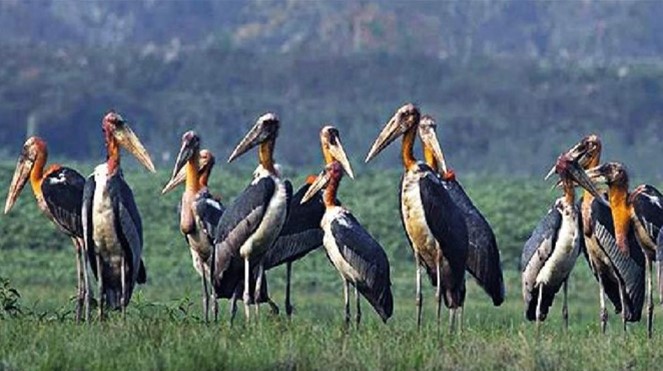
Source:
Image Source:
India’s new category visa to fast-track requests
- Context: Ministry of Home Affairs has announced a new category of visa called 'e-Emergency X-Misc Visa to fast-track applications from Afghanistan for entry into India.
- It is new category of electronic visas to fast-track applications of Afghans who want to relocate to India after Taliban’s capture of power in Afghanistan.
- The Ministry of External Affairs has also set up a special Afghanistan cell to coordinate repatriation and other requests from Afghanistan territory.

Source:
Image Source:
Taliban has taken Kabul. Delhi must watch, not pronounce doom
Essence: The opinionated article discusses the conclusive end to the struggle for power in Afghanistan which culminated with Taliban taking over Kabul recently. The article provides a vision of how and what should alter India’s foreign policy approach after the overtake of Afghanistan by the Taliban. India and Afghanistan share a common history ranging from medieval times to modern history of colonial invasion. The mention of the “Panikkar Thesis” in the article lays out the futuristic approach for India to wait and instil its faith that trade, and business would resume. Moreover, Indian leadership should be aware and prepared for encountering possible cross-border terrorism. With Pakistan getting foreign aid, and providing support to “Taliban Terror”, the situation is a worrisome for India’s security.
Why you should read this article?
- To understand the impact of takeover of Afghanistan by Taliban.
- To understand the cause and effect of Afghanistan’s future over India’s foreign relations.
- To understand the vision of K M Panikkar in relation to the present crisis.
Source:
The Message from The IPCC Report
Essence: The Article discusses the findings of the 6th Assessment Report (AR6) by the Intergovernmental Panel on Climate Change (IPCC) and the ways to achieve the Paris Agreement targets. The report reiterates how the global surface temperature is higher by 1.070 C since pre-industrial era and increased incidences of climate extremes due to global warming.
The report also mentions that equitable cumulative emission targets in reaching Net Zero Emission will help in restricting global temperature rise. Given the Historic emissions by the Developed countries they should completely phase out fossil fuels and provide financial aid to fulfil their climate obligations and reach Net Zero targets well before 2050.
Why you should read this Article?
- To understand the importance of Cumulative Emission Targets to achieve Climate Goals determined in Paris Climate deal.
- To understand the stand of India regarding Global Climate.
Source:
What central bank digital currency is and isn’t
Essence: This article is written in backdrop of impending parachuting of Central Bank Digital Currency (CBDCs) in many developing and emerging economies including India. Article discusses how CBDCs are different from crypto currencies. It further discusses the benefits of digital rupees and how they will complement physical cash specially in extraordinary situation like Pandemic. Several reports assert that, co-existence of centralized, decentralized, account and token based CBCDs and crypto currencies with traditional digital and physical currencies is the future.
Why should you read this article?
- To understand what CBDC is and how it complements physical cash.
- To understand the difference between CBDCs and crypto currencies and what are the benefits associated with CBDCs.
Source:
El Salvador certified as malaria-free
What does malaria free mean
- Certification of malaria elimination is granted by WHO when a country has proven, beyond reasonable doubt, that the chain of indigenous transmission has been interrupted nationwide for at least the previous 3 consecutive years.
Case study of El Salvador
- It has become the first country in Central America to get the malaria-free certificate from WHO in recent years.
- Efforts began in the 1940s with mechanical control of the malaria vector: the mosquito
- In mid-1950s, National Malaria Program was launched to treat malaria across the country
- Volunteers known as “Col Vol” registered malaria cases and allowed for strategic and targeted responses across the country
- The government decentralized its network of diagnostic laboratories in 1987, allowing for cases to be detected rapidly.
- Commitment has been reflected in national budget lines through constant funding.
Where can we use this case study?
- GS PAPER 2: Issues Relating to Development and Management of Social Sector/Services relating to Health, Education, Human Resources.
Sources:
Share the article
Get Latest Updates on Offers, Event dates, and free Mentorship sessions.

Get in touch with our Expert Academic Counsellors 👋
Frequently Asked Questions
UPSC Daily Current Affairs focuses on learning current events on a daily basis. An aspirant needs to study regular and updated information about current events, news, and relevant topics that are important for UPSC aspirants. It covers national and international affairs, government policies, socio-economic issues, science and technology advancements, and more.
UPSC Daily Current Affairs provides aspirants with a concise and comprehensive overview of the latest happenings and developments across various fields. It helps aspirants stay updated with current affairs and provides them with valuable insights and analysis, which are essential for answering questions in the UPSC examinations. It enhances their knowledge, analytical skills, and ability to connect current affairs with the UPSC syllabus.
UPSC Daily Current Affairs covers a wide range of topics, including politics, economics, science and technology, environment, social issues, governance, international relations, and more. It offers news summaries, in-depth analyses, editorials, opinion pieces, and relevant study materials. It also provides practice questions and quizzes to help aspirants test their understanding of current affairs.
Edukemy's UPSC Daily Current Affairs can be accessed through:
- UPSC Daily Current Affairs can be accessed through Current Affairs tab at the top of the Main Page of Edukemy.
- Edukemy Mobile app: The Daily Current Affairs can also be access through Edukemy Mobile App.
- Social media: Follow Edukemy’s official social media accounts or pages that provide UPSC Daily Current Affairs updates, including Facebook, Twitter, or Telegram channels.






